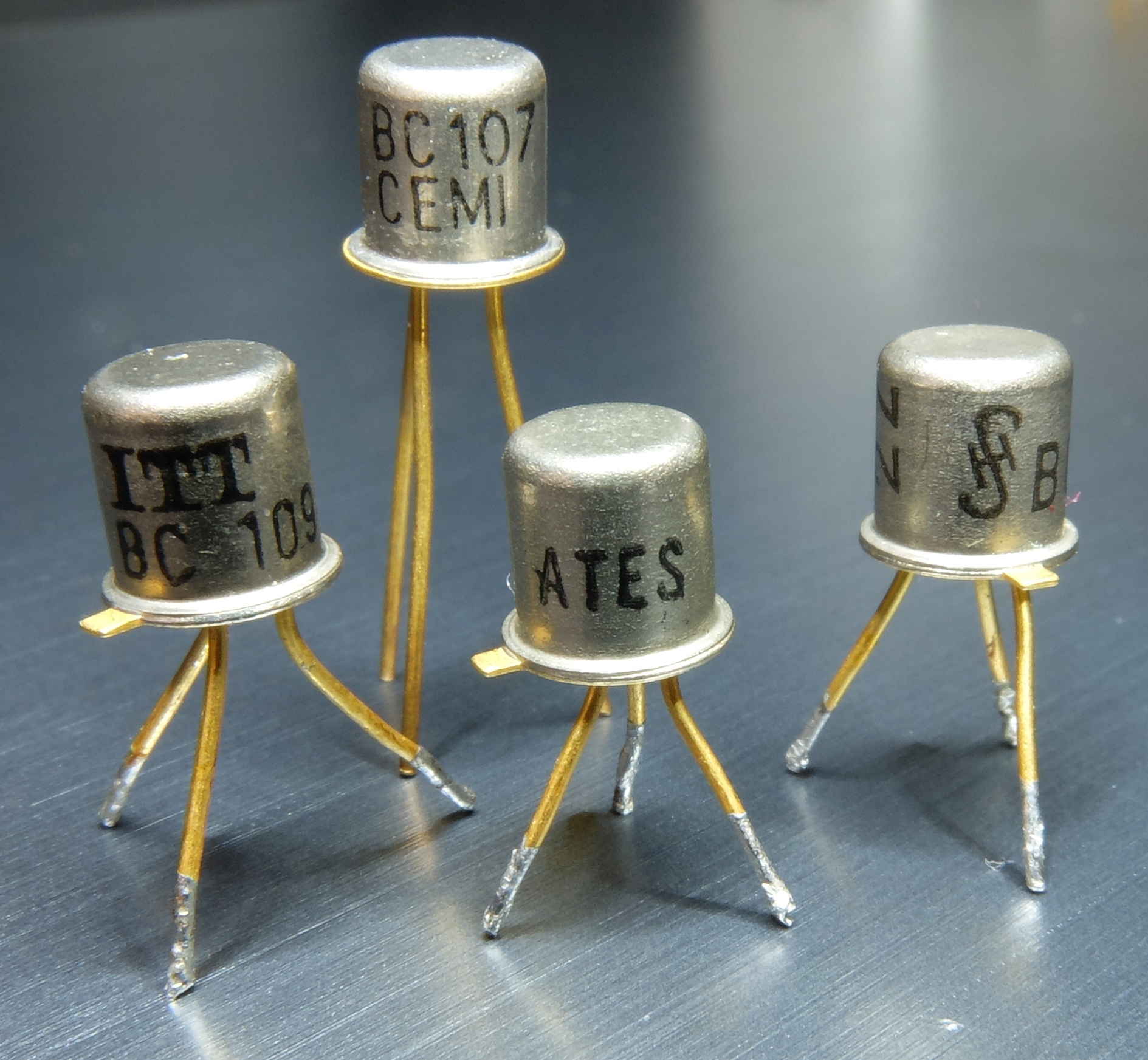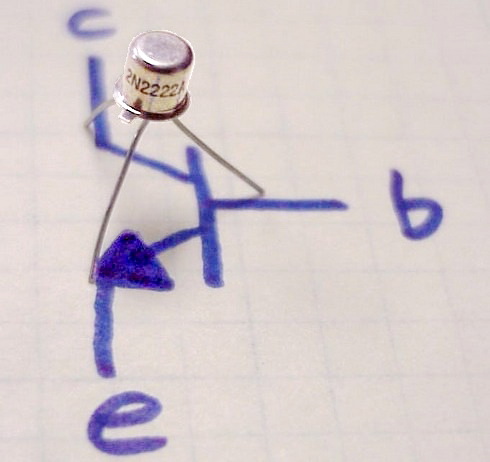|
BC548
The BC548 is a general-purpose NPN bipolar junction transistor commonly used in European and American electronic equipment. It is notably often the first type of bipolar transistor hobbyists encounter and is often featured in designs in hobby electronics magazines where a general-purpose transistor is required. The BC548 is low in cost and widely available. History and usage The BC548 is a part of a family of NPN and PNP epitaxial silicon transistors that originated with the metal-cased BC108 family of transistors. The BC548 is the modern plastic-packaged BC108; the BC548 article at the Radiomuseum website describes the BC548 as a successor to the BC238 and differing from the BC108 in only the shape of the package. Datasheets for the BC548 give specifications that are identical to, or exceed, those of the BC108, BC148 and BC238 predecessors. Thus the BC548 (or BC546 to 550) is a valid substitute in any circuit designed for the older BC108 (or BC148), which includes many Mullard an ... [...More Info...] [...Related Items...] OR: [Wikipedia] [Google] [Baidu] |
BC108 Family
The BC107, BC108 and BC109 are general-purpose low power silicon NPN bipolar junction transistors found very often in equipment and electronics books/articles from Europe, Australia and many other countries from the 1960s File:1960s montage.png, Clockwise from top left: U.S. soldiers during the Vietnam War; the Beatles led the British Invasion of the U.S. music market; a half-a-million people participate in the 1969 Woodstock Festival; Neil Armstrong and Buzz .... They were created by Philips and Mullard in 1963 and introduced in April 1966. Initially in metal (TO-18) packages, the range expanded over time to include other package types, higher voltage ratings, and a better selection of gain (hFE and hfe) groupings, as well as complementary BC548#PNP Versions of BCxxx, PNP types. Some manufacturers have specified their parts with a higher power dissipation rating (Ptot) than others. The BC548 is an example of the modern low-cost member of this family, still in a through-hol ... [...More Info...] [...Related Items...] OR: [Wikipedia] [Google] [Baidu] |
TO-92
The TO-92 is a widely used style of semiconductor package mainly used for transistors. The case is often made of epoxy or plastic, and offers compact size at a very low cost. History and origin The JEDEC TO-92 descriptor is derived from the original full name for the package: Transistor Outline Package, Case Style 92. The package is also known by the designation SOT54. By 1966 the package was being used by Motorola for their 2N3904 devices among others. Construction and orientation The case is molded around the transistor elements in two parts; the face is flat, usually bearing a machine-printed part number (some early examples had the part number printed on the top surface instead). The back is semi-circularly-shaped. A line of moulding flash from the injection-moulding process can be seen around the case. The leads protrude from the bottom of the case. When looking at the face of the transistor, the leads are commonly configured from left-to-right as the ''emitter'', ''ba ... [...More Info...] [...Related Items...] OR: [Wikipedia] [Google] [Baidu] |
2N2222
The 2N2222 is a common NPN bipolar junction transistor (BJT) used for general purpose low-power amplifying or switching applications. It is designed for low to medium current, low power, medium voltage, and can operate at moderately high speeds. It was originally made in the TO-18 metal can as shown in the picture. The 2N2222 is considered a very common transistor, and is used as an exemplar of an NPN transistor. It is frequently used as a small-signal transistor, and it remains a small general purpose transistor of enduring popularity. The 2N2222 was part of a family of devices described by Motorola at a 1962 IRE convention. Since then it has been made by many semiconductor companies, for example, Texas Instruments.''The Transistor and Diode Data Book for Design Engineers'', Texas Instruments Incorporated, no date, TI publication number CC413 71242-73-CSS, page 4-93 Specifications The JEDEC registration of a device number ensures particular rated values will be met by all p ... [...More Info...] [...Related Items...] OR: [Wikipedia] [Google] [Baidu] |
2N3906
The 2N3906 is a commonly used PNP bipolar junction transistor intended for general purpose low-power amplifying or switching applications. It is designed for low electric current and power and medium voltage, and can operate at moderately high speeds. Overview The 2N3906 is manufactured in a plastic TO-92 case. When looking at the flat side with the leads pointed downward, the three leads emerging from the transistor are, from left to right, the emitter, base, and collector leads. The 2N3906 is specified by a collector current of 200 mA, collector-base and collector-emitter voltages of 40 V, for power dissipation of 300 mW. Its transition frequency Ft is 250 MHz, with a beta of at least 100. The complementary NPN transistor to the 2N3906 is the 2N3904. Both types were registered by Motorola Semiconductor in the mid-1960s. Part numbers The 2N3904 (NPN) and 2N3906 (PNP) are complementary transistor pairs. These transistors are available in package styles TO-92, SOT2 ... [...More Info...] [...Related Items...] OR: [Wikipedia] [Google] [Baidu] |
Pro Electron
Pro Electron or EECA is the European type designation and registration system for active components (such as semiconductors, liquid crystal displays, sensor devices, electronic tubes and cathode ray tubes). Pro Electron was set up in 1966 in Brussels, Belgium. In 1983 it was merged with the European Electronic Component Manufacturers Association (EECA) and since then operates as an agency of the EECA. The goal of Pro Electron is to allow unambiguous identification of electronic parts, even when made by several different manufacturers. To this end, manufacturers register new devices with the agency and receive new type designators for them. Designation system Examples of Pro Electron type designators are: * AD162 – Germanium power transistor for audio frequency use * BY133 – Silicon rectifier * BZY88C5V1 – Silicon 5.1 volt Zener diode * CQY97 – light emitting diode * ECC83 – 6.3 volt heater noval dual triode * A63EAA00XX01 – Color TV pic ... [...More Info...] [...Related Items...] OR: [Wikipedia] [Google] [Baidu] |
2N2907
The 2N2907 is a commonly available PNP bipolar junction transistor used for general purpose low-power amplifying or switching applications. It is designed for low to medium current, low power, medium voltage, and can operate at moderately high speeds. This transistor was made by several manufacturers; Texas Instruments released a data sheet for their version of this part dated March 1973. An "A" suffix indicates a slightly higher breakdown voltage. These transistors have an enduring popularity with electronics hobbyists. Specifications It is a 0.6-ampere, 60-volt, 400-milliwatt transistor. For the 2N2907, the gain–bandwidth product under specified test conditions, or , is 200 Megahertz, which is notionally the frequency at which the current gain drops to one. Practical use of a transistor requires that it be used for frequencies much less than . At low frequencies, the current gain (beta) is at least 100. The 2N2907 is used in a variety of analog amplification and switching appli ... [...More Info...] [...Related Items...] OR: [Wikipedia] [Google] [Baidu] |
Megahertz
The hertz (symbol: Hz) is the unit of frequency in the International System of Units (SI), equivalent to one event (or Cycle per second, cycle) per second. The hertz is an SI derived unit whose expression in terms of SI base units is s−1, meaning that one hertz is the reciprocal of one second. It is named after Heinrich Hertz, Heinrich Rudolf Hertz (1857–1894), the first person to provide conclusive proof of the existence of electromagnetic waves. Hertz are commonly expressed in metric prefix, multiples: kilohertz (kHz), megahertz (MHz), gigahertz (GHz), terahertz (THz). Some of the unit's most common uses are in the description of periodic waveforms and musical tones, particularly those used in radio- and audio-related applications. It is also used to describe the clock speeds at which computers and other electronics are driven. The units are sometimes also used as a representation of the photon energy, energy of a photon, via the Planck relation ''E'' = ''hν'', ... [...More Info...] [...Related Items...] OR: [Wikipedia] [Google] [Baidu] |
KT315
The KT315 is a Soviet silicon NPN bipolar junction transistor used for general-purpose low-power amplifying or switching applications, enclosed in the plastic KT-13 package. It was widely used in Soviet electronic equipment. The KT361 is a complementary ( PNP) for the KT315 transistor, so it was often paired with it in push-pull stages. KT315 and KT361 transistors became the first in the USSR, which were produced using planar technology. The characteristics achieved in the KT315 were groundbreaking in Soviet technology at that time. The process of manufacturing was much cheaper than the alloy-junction technology, and the parameters surpassed those of earlier transistor types, in particular, the unity-gain frequency was 250 MHz. The people associated with the development and mass-production launch of the KT315 were awarded the USSR State Prize for it in 1973. Application KT315 transistors were designed for use in high-, medium- and sound-frequency amplifying stages. ... [...More Info...] [...Related Items...] OR: [Wikipedia] [Google] [Baidu] |
2N3055
The 2N3055 is a silicon NPN power transistor intended for general purpose applications. It was introduced in the early 1960s by RCA using a hometaxial power transistor process, transitioned to an epitaxial base in the mid-1970s. Its numbering follows the JEDEC standard. It is a transistor type of enduring popularity. Specifications The exact performance characteristics depend on the manufacturer and date; before the move to the epitaxial base version in the mid-1970s the fT could be as low as 0.8 MHz, for example. Packaged in a TO-3 case style, it is a 15 amp, 60 volt (or more, see below), 115 watt power transistor with a β (forward current gain) of 20 to 70 at a collector current of 4 A (this may be over 100 when testing at lower currents). It often has a transition frequency of around 3.0 MHz and 6 MHz is typical for the 2N3055A; at this frequency the calculated current gain (beta) drops to 1, indicating the transistor can no longer provide useful ... [...More Info...] [...Related Items...] OR: [Wikipedia] [Google] [Baidu] |
Breakdown Voltage
The breakdown voltage of an insulator is the minimum voltage that causes a portion of an insulator to experience electrical breakdown and become electrically conductive. For diodes, the breakdown voltage is the minimum reverse voltage that makes the diode conduct appreciably in reverse. Some devices (such as TRIACs) also have a ''forward breakdown voltage''. Electrical breakdown Materials are often classified as conductors or insulators based on their resistivity. A conductor is a substance which contains many mobile charged particles called charge carriers which are free to move about inside the material. An electric field is created across a piece of the material by applying a voltage difference between electrical contacts on different sides of the material. The force of the field causes the charge carriers within the material to move, creating an electric current from the positive contact to the negative contact. For example, in metals one or more of the negatively cha ... [...More Info...] [...Related Items...] OR: [Wikipedia] [Google] [Baidu] |

.jpg)


